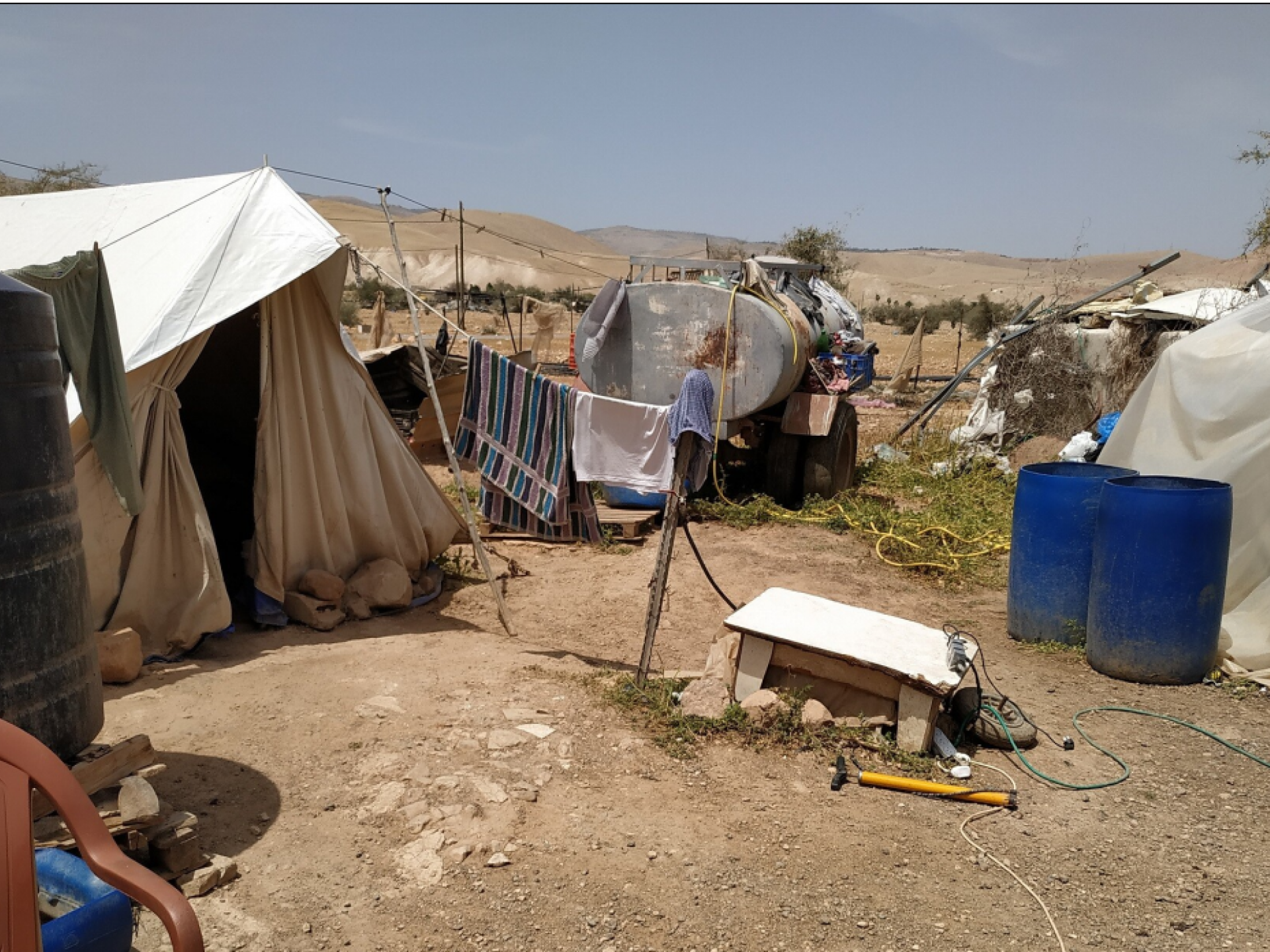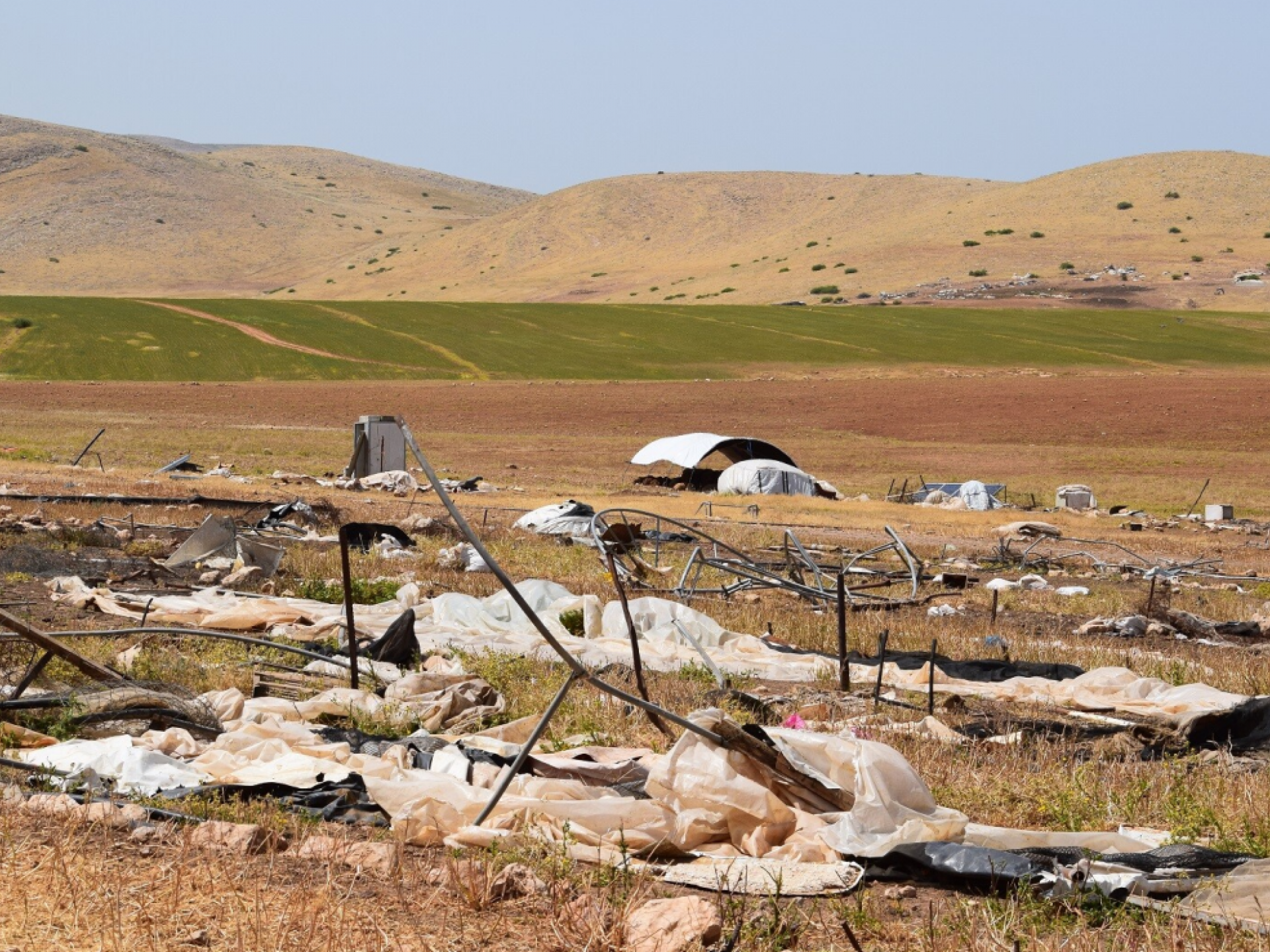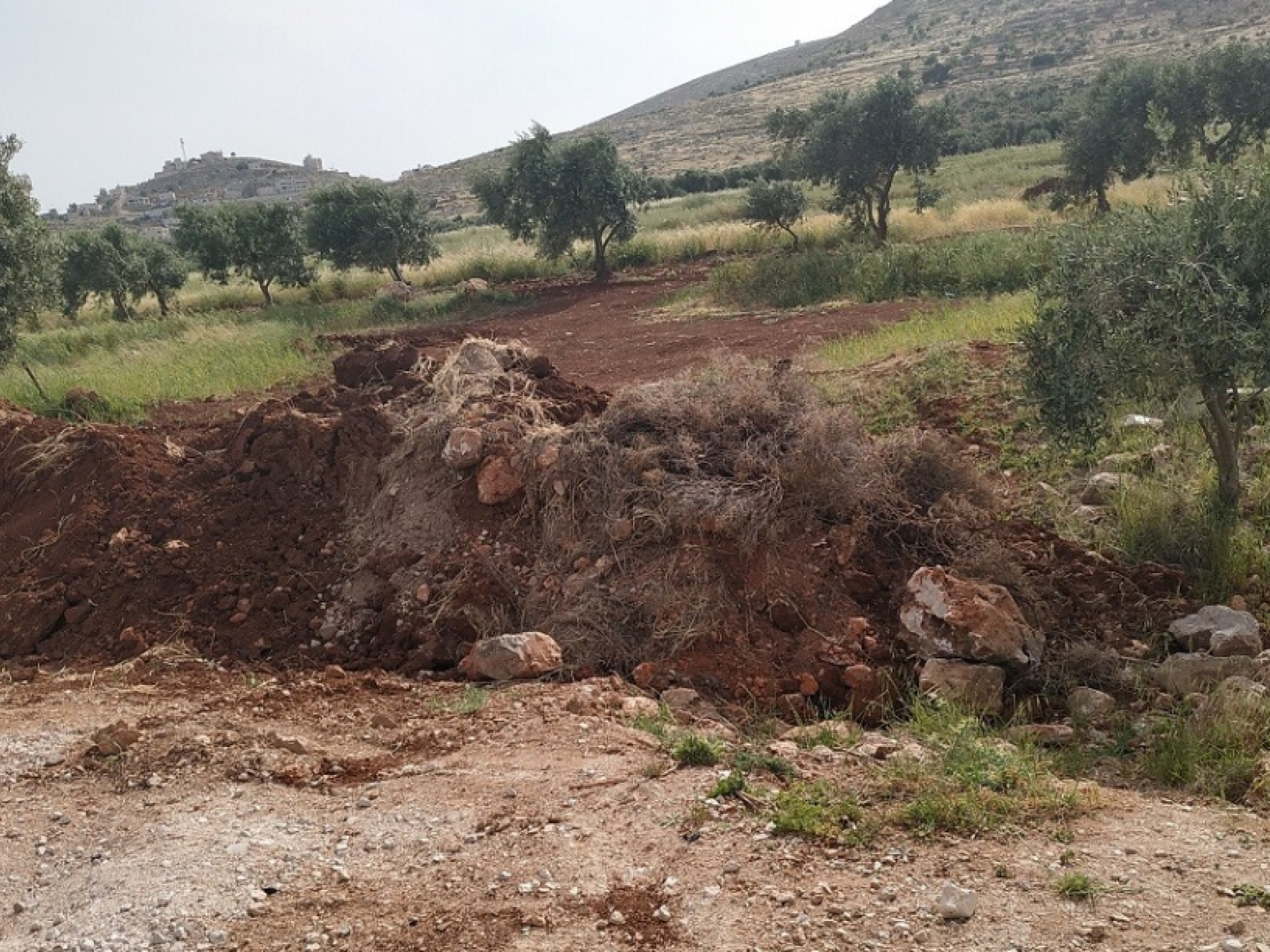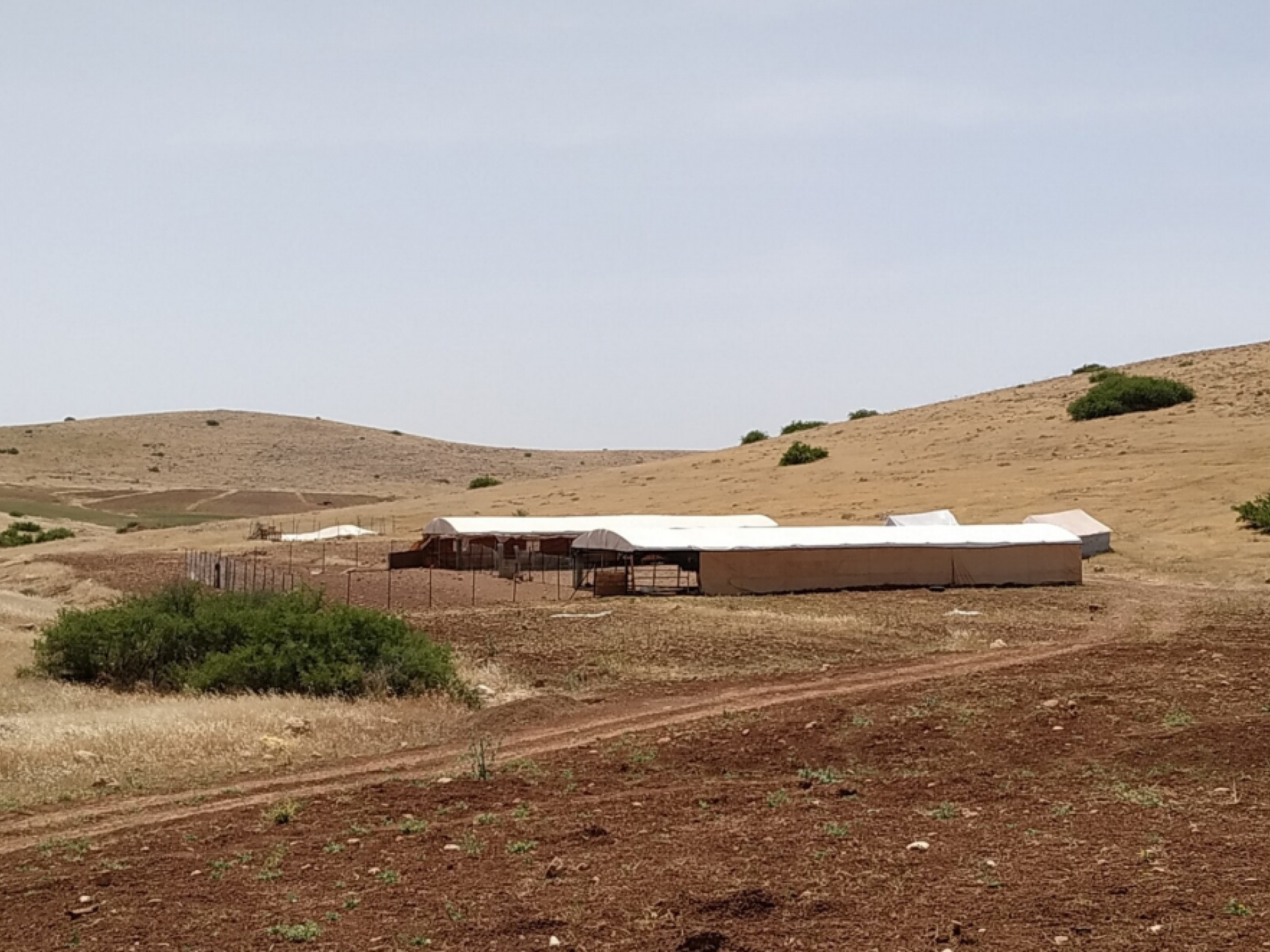Jordan Valley: In pursuit of the cruelty of the occupation
We met as usual, at 9 a.m. at Yarkon interchange.
At the Yatma Junction vegetable stall which we know from previous vigils, we bought plenty for 3 families – 3 full crates at a ridiculous price.
Near Duma we turned south, opposite an especially violent settler-colonist outpost “Angels of Peace” (Mal’achei ha-Shalom) whose name is inappropriate, to put it mildly…
At Ein Rashash we met Moussa and his nice wife whom we hadn’t visited for quite a while, and we were all glad to meet again. Until a year ago we – activists in the Palestinian Jordan Valley – accompanied these communities and with them witnessed harsh violence from the settler-colonists of “Angels of Peace”. A year ago the Palestinians gave up and now all the area’s shepherd communities graze near home. Even now, as summer only begins, the grass growing less, meaning that they will have to feed their sheep purchased fodder. They even keep away from the spring beneath their home with their livestock, and are forced to import water.
From there we sought the track going down to Fasail, among the hills, having heard shepherds from there complain that far down on road 90 Elchana of the said outpost has been chasing them from their own grazing grounds, for “the entire area from Maale Efrayim to Al Auja (thousands of dunams all inside declared firing zones) belongs to me!” He carries a gun and threatens them. Have dozens of shepherds from Fasail been doomed to the same fate as those from En Rashash?
Daphne – our brave driver – found her way on the unpaved track, filled with rocks, winding between the hills. We wished to find the track which Elchanan, the mean settler-colonist (from that outpost), uses to reach the Palestinian flocks grazing around Fasail. At some point, the track became impossible for driving any vehicle that is not equipped with 4-wheel drive, so light-footed Nurit ran up to the opposite hill and, from a distance, photographed the outpost cowshed and the path that leads to it, right on the border of the firing zone marked on the map.
On our way back, Nurit and her navigation skills and Daphne behind the wheel managed to get us out of this potholed and rocky track, and reach the main road. On the main road we noticed that all the exits from Palestinians’ groves to the main road have been newly blocked by rock piles and soil.
In Fasail we met with Maryam whose home was demolished half a year ago, and again a month later, and in November for the third time, until the family just gave up and does not even clear the rubble any longer. This is a very ill family. Maryam has been going blind because of severe diabetes. She does receive injections into her eyes that do delay blindness for a bit. Her leg is very swollen and warped, in a splint. Her husband, also suffering from severe diabetes, went to a doctor in Nablus. The doctors there are trying to save his leg from being amputated. I look around me and realize I could not live in such circumstances. All around is rubble of the multiple demolitions, all dried and filthy.
The only healthy and active member of this miserable family is Dalal, wife of Imad, their son. The couple live in a small pup tent. In spite of these harsh living conditions, she is always doing the laundry, smiling and laughing. They have no children, and if I thought to offer medical solutions for this, I have given up in view of their living conditions. A harsh visit! One of the most difficult factors is the lack of welfare services for such people who have not had any kind of medical attention for a long period of time and suffer prolonged neglect. We often deliberate whether we should take upon ourselves such extreme economic hardship, even because we could not commit to helping for a longer period. On the other hand, one cannot disregard their condition. Donations for help would be welcomed (to Tzvia by BIT or to account number 900129089665 at the Israel Post Bank).
We proceeded to Humsa and met our friend Fatma and her two 2-year-olds. Here the tent is clear and airy and pleasant to sit in. Fatma and her family erected their tents in an area that is outside the firing zone, but still inside Humsa. Their attorney, Tawfiq Jabareen, has attained a restraining order against demolishing their new domicile. The area outside the firing zone is small and not all 11 families can move there. We spoke about the Ramadan fast, demolitions which the army carried out in Humsa 2 months ago, and gave them a vegetable crate.
From there we drove long into the dry heat of early summer.We reached another encampment which the army had demolished. What a depressing sight – rubble all around, everything done by the “most moral army in the world”…
Daphne has some carrots to feed donkeys we meet on our way, so here too she fed one standing in the sun…
We sat at the entrance to Ayisha’s tent – she suffers severe back pains because of which she always has to bend down. We sat there with her bachelor son Ahmad who never stops talking, telling things and laughing. It’s nice to sit here with them even here, in spite of the harsh living conditions and the army’s constant harassment. They always welcome us warmly and the atmosphere is pleasant. On our way out we met Ayisha’s son who left his car outside someone’s tent in outside the firing zone, for fear it would be confiscated.
In the afternoon we went to meet Rabbi Arik Asherman, who was crutally attacked last week by settler-colonists at Deir Jarayer. We meant to go to the sown fields at Tayibe Junction (near the settler-colony Rimonim on the West Bank hill range) because settler-colonists from the illegal outpost of Neriya Ben Pazi invade it regularly with their cows and destroy the crops the Palestinians had labored to produce.
We switched from the main road to the dirt track and saw the cows – many of them – grazing on a Palestinian owned and tended field. A very young 13-year-old settler-colonist on horseback was directing them into the field. We approached and yelled at him to get his cattle out of there. He rode away indifferently. We called Arik who asked us to call the regional brigade war-room, but they told us they don’t accept calls from civilians, we should talk to the police.
We called the police but it took about 40 minutes to get there, and in the meantime the flock had trampled and eaten everything that hard working farmers sweated and labored over all winter. Nurit approached the youngster on his horse and tried to chase the cows away. She photographed him photographing her, and as he got nearer to her on his horse it looked pretty scary. This youngster mocked her and spoke nonsense. She realized this was merely a 9th grader already behaving like a “lord of the land”.
Daphne called the police and sent them a Whatsapp message with the exact location. They promised to send a car right away but it showed up after half an hour and in the meantime the settler-colonists’ flock continued to dine.
Policeman Haggai who finally arrived said we should go to the Binyanim police to lodge a complaint, along with the landowner, numbered the incident “4971”, and that was it for police treatment.
Since I am a member of Yesh Din (human rights organization specializing in Palestinians’ complaints about harassment by settler-colonists) I am well-acquainted with the fate of our complaints. We will certainly go to the police, look for the landowner, and it will all amount to nothing.
It became gradually dark, we felt we had done enough for one day, but didn’t end the occupation…





